Introduction
SteelSeries’ Apex Pro line of keyboards has been a mainstay in our pro gear lists, especially in games such as Fortnite where it managed to carve out a reputation for itself as kind of the ‘standard competitive board’ for a while thanks to its features such as the customizable actuation point. For the longest time, the smallest available Apex Pro board was the TKL version, and with the rising popularity of smaller form factor keyboards it was only a matter of time before SteelSeries released an updated version of their extremely popular keyboard.
Recently, the Apex Pro Mini was released. This 60% version comes in two different versions; a wired version and a wireless version. Today, we’re taking a look at the wired version. Has SteelSeries managed to make their boards meet the expectations of keyboard fanatics in 2022, and is the Apex Pro still the board to look at if you’re a competitive gamer? Read our full SteelSeries Apex Pro Mini review to find out!
At A Glance
SteelSeries Apex Pro Mini Black
I think I can summarize this review in one sentence: the SteelSeries Apex Pro Mini is the best dedicated gaming keyboard I’ve ever used, and it’ll definitely be my main gaming keyboard in the foreseeable future.
Pros
- Customizable switches
- Nice keycaps
- Good stabilizers
- OmniPoint 2.0 switches feel very smooth and pleasant to use
Cons
- Can’t save lighting profiles to the onboard memory
- High price
Specs
| Form Factor | 60% |
|---|---|
| Switches | OmniPoint 2.0 |
| PCB | Non-Hotswappable |
| RGB | Yes |
| Height | 4.04cm |
| Width | 29.3cm |
| Length | 10.3cm |
| Weight | 610g |
Usage Over Time In The Pro Scene
First Impressions
Since the release of the Apex Pro TKL all those years ago the keyboard market has moved a lot. The custom mechanical keyboard market has seen a big rise in popularity since the COVID pandemic, leading to increased expectations with regular customers. Slapping some subpar ABS keycaps on a premium keyboard just won’t cut it anymore, for example, so I was glad to see that the people at SteelSeries have been keeping an ear to the ground and have been taking a look at what customers are expecting these days. We see PBT keycaps on this Apex Pro Mini, for example.
Aside from comparing it to the older versions, there’s not a whole lot to note about the Apex Pro Mini at first sight. With its small bezels it’s an extremely compact keyboard that has cut down on extras (like the display that you had on the Apex Pro TKL) in order to focus on what ultimately matters with these kinds of keyboards: performance.
Once plugged in, the board looks great. The RGB isn’t the brightest, but the legends on the keys themselves are fairly consistent with the amount of light they let through, and color gradient effects look smooth and natural without any choppiness when they switch colors or what have you. The RGB is something that SteelSeries does well, doubly so because you can set up dynamic RGB profiles that respond to the game you’re playing (if you’re playing a compatible game). Seeing your keyboard’s lighting flicker when you’ve landed a headshot in CS:GO, for example, isn’t something that’s gonna aid with your performance, but it is cool to see in action. Fans of impressive light shows thus won’t be disappointed with this keyboard.
Packaging
Inside the box, you’ll find the board, a quickstart guide, a (rather nice) braided cable, and that’s it. On the bottom of the keyboard there’s a compartment that holds a keycap puller as well, so that’s always nice to see that included. That whole keycap holder area seems a bit overkill, but I used it to store the receiver dongle for my mouse when I went to a LAN the other week, so that’s a nice extra.
Features and Build
The Apex Pro Mini is, as you can see, a 60% board. This means that you’ll lose out on certain buttons such as the F row and the arrow keys, but of course you can still access those by pressing the function key (on this board represented by the SteelSeries logo) in combination with another key. What I particularly love here is that the lighting of the keyboard changes when you press this function key. This makes it super easy to find where the arrow keys are without having to peer at the legends printed on the front of the keys, since those arrow keys are on WASD by default, which is in a cluster that’s separated from the other secondary function keys. As a result, the arrow keys light up as if they’re on an island when you press the function key.
I always struggle the most with finding the arrow keys on new 60% boards, and since I use those a lot it can take me out of the flow if I have to look for them every time so it’s fantastic that they almost literally tell you where they are on this board once you press the function key. I don’t know whether they did this on purpose or not but I love it. Sometimes it’s the little things that can make or break a product, and this is a great example of one of those ‘make’ features.
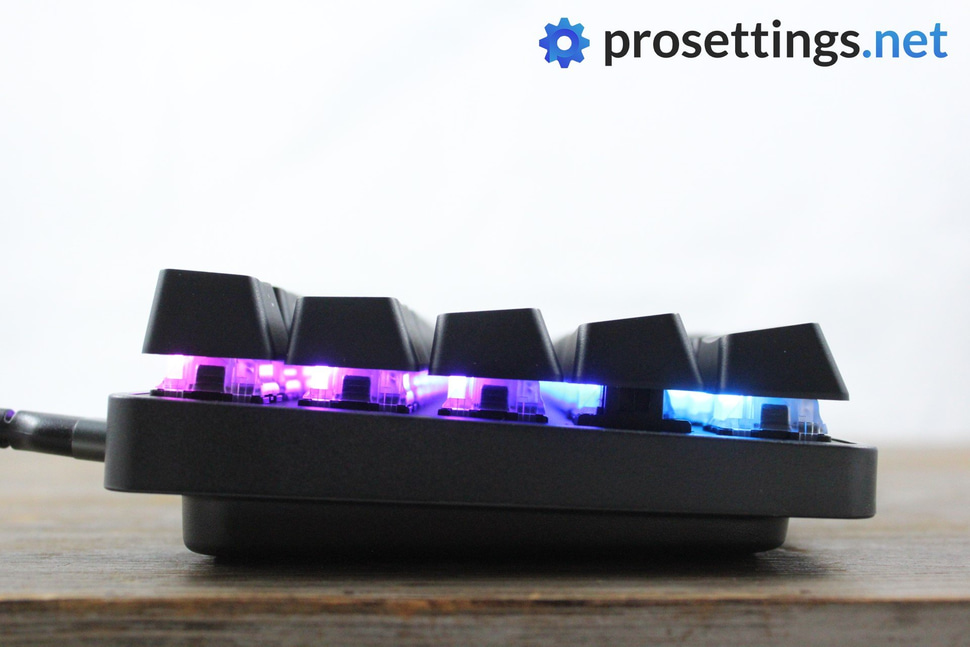
The case of the Apex Pro Mini is entirely made out of plastic, and I find that to be a touch disappointing. Given the price they’re asking for this board, it would be nice to see an aluminum case. I know that this is not something that’s common (even in higher tier mass-produced keyboards) so I won’t pretend that it’s a must but it would’ve been a little extra touch to set the board even further apart from the competition. There’s also a certain amount of flexing when applying pressure to the sides of the board as you’re holding it in your hands. Thanks to the aluminum backplate there isn’t any flexing when using it normally though, so this is not something that will influence the day-to-day performance.
Something that’s also nice is the fact that the board has enough space to fit custom USB-C cables, which is always a major plus to me.
As I briefly mentioned before, the Apex Pro Mini comes with PBT keycaps. This is something that’s expected of higher tier keyboards these days, and these caps deliver. They’re finely textured for that little bit of extra grip, and the caps themselves are thick and solid. This is a major upgrade if you’re coming from an older Apex Pro, and even though it’s an expected upgrade it’s nice to see it executed properly. The caps perform and feel fine, even after using the board for multiple hours-long sweaty gaming sessions.
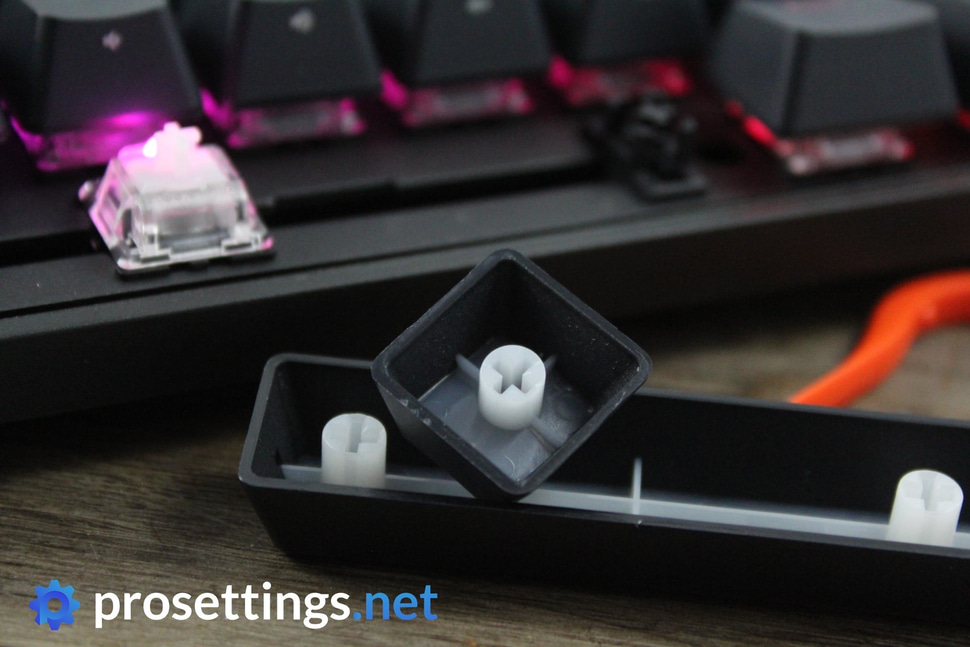
On the bottom of the keyboard you’ll find two sets of flip up feet, giving you a total of three positions in which you can place the board. Sadly, these feet don’t have rubber elements on the bottom, and the board can get slippery when using the feet on a smooth desk. Not in the sense that the board suddenly slips away from you, but I did notice that my keyboard had moved a centimeter or two after a particularly intense match. This isn’t a deal-breaker, but it would’ve easily been solved by placing rubber pads on the bottom of the flip-up feet. When using the board in its flat configuration (which is how I use all of my keyboards; I merely tested the feet for a couple of matches) it stays exactly where you left it though, so no issues there.
What you’ll also find on the bottom of the Apex Pro Mini is a big rubber hatch housing a keycap puller. That’s kind of a pompous way of storing a keycap puller if you ask me, but as an added bonus the rubber element gives you extra grip when using the keyboard without the flip-up feet, which is something that I’m all for. And, as mentioned, it also doubles as a handy storage compartment for wireless receivers that you can’t store on the peripherals themselves, such as mouse receivers.
Performance and Everyday Usage
Obviously, the OmniPoint 2.0 switches are the big selling point of the Apex Pro Mini. These 2.0 switches are 50% faster in their actuation and 33% faster in their response time and the actuation range is now between 0.2 and 3.8 mm (this was 0.4 and 3.6 mm on the 1.0 switches) but the essence remains the same: these are linear switches with an adjustable actuation point. You can learn more in our OmniPoint switches article.
In case you’re wondering what ‘actuation point’ is: it’s the point at which the switch detects your keystroke. If you have an actuation point of 0.2 mm, you need to press the key only 0.2 millimeters before it registers as a press. As you may be able to tell, this is an incredibly low amount of travel. Playing with the keys at 0.2 mm means that they actuate if you so much as sneeze in the direction of the keyboard, so I don’t necessarily recommend going for the absolute lightest setting, but the beauty of the OmniPoints is that you can freely experiment with this.
Because of the fact that you can change each individual key, the possibilities are endless. You can have your movement keys be extremely sensitive, for example, while you have your ultimate ability set to an actuation point that means that you basically have to press it all the way down in order to prevent fat-fingering it. Or you could have one super sensitive profile for gaming, and switch to a more robust keystroke for productivity. It’s up to you, and this functionality really works great.
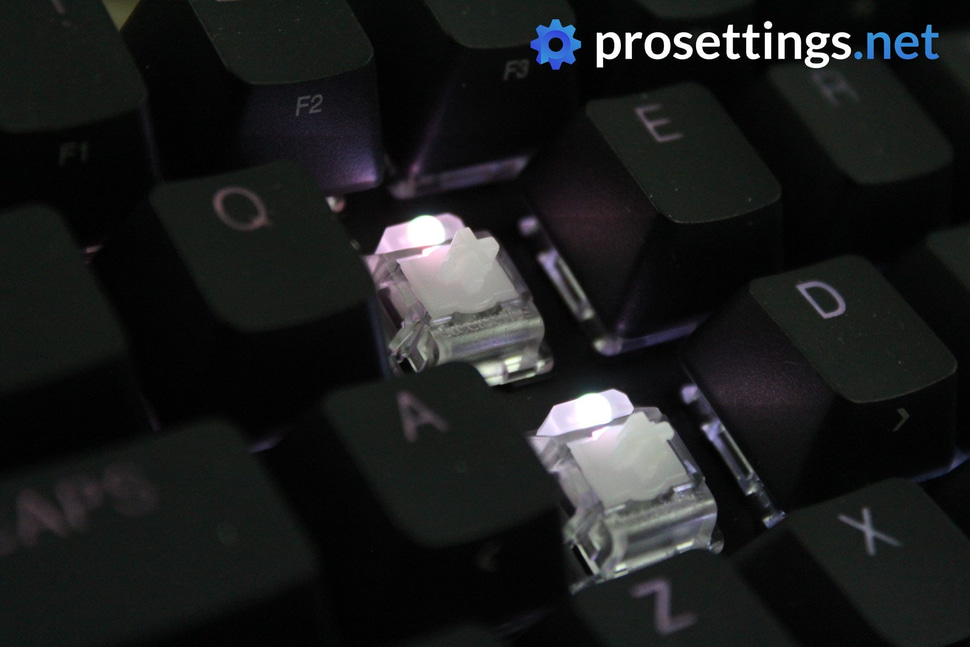
There also is a very clear difference between different actuation points. At its lowest, the board is hair-trigger light to the point where it was way too light for me, and at its heaviest you really have to push you key all the way down before it registers, leading to a much heavier required typing/playing force. Of course you can also use any value in between those 0.2 mm and 3.8 mm values for a middle ground option, but if you’re thinking that this feature is a gimmick then think again. Whether or not this useful to you personally is of course something that you will need to decide for yourself, but the different levels very clearly make a difference when gaming.
These new OmniPoints not only let you customize the actuation point, however. You can program multiple actions to a single key. An obvious example is movement: you can have it so that lightly pressing a key results in your character walking, and pressing it all the way down makes you run. I can imagine this feature coming in handy in games like Fortnite, where you could program a key to select a building material when pressed lightly and to have it build when pressed all the way so that you can build at extreme speeds.
The customization possibilities are nearly endless, though, and that’s the beauty of this keyboard: you can really tweak this to match your preferences and playing style perfectly so that you’ve got an almost completely custom experience that you can even tweak to match the input needs of different games.
All of this of course sounds great, but it would be a big bummer if the board itself didn’t feel good to use every single day, and I’m glad to say that it does. The Apex Pro Mini is a bit on the louder side, but I like the way that it sounds, and the stabilizers also feel and sound remarkably nice for a mass-produced keyboard. I could make out some really small blotches of lube on them, and even though they’re obviously not a match to a custom-built, hand-lubed keyboard stabilizers I have absolutely no issues with the typing and gaming experience of this keyboard.
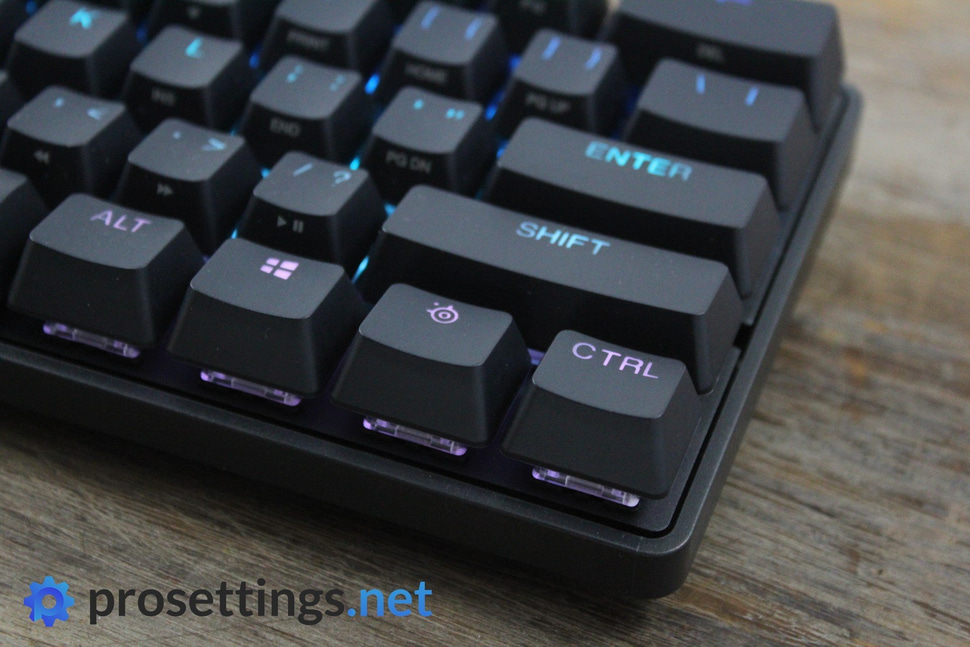
The switches themselves feel great to use, too. They are very smooth, and with their 45G required actuation force they feel just right for gaming if you ask me. I’m not a hyper-critical switch aficionado, but I do have a couple of custom keyboards under my belt and I wouldn’t hesitate to use these switches in one of those, even if it wasn’t for the customization options since they feel really good to use to me.
SteelSeries’ GG software has a bit of a learning curve to it initially, but it’s a very expansive piece of kit that allows you to adjust this keyboard in pretty much any way you want it to. You can program macros to your heart’s content, so people who like to tinker with their gear are going to be right at home with the Apex Pro Mini.
Then there’s the question as to whether or not this board will make you a better player, and I would say that it depends. There’s not a single piece of gear out there (be it a mouse, a keyboard, or something else) that will allow you to shoot up the ranks instantly, for example. I do firmly believe that getting the right gear that matches your preferences and playing style can make your more consistent and, in some cases, make you a better player. It might only make you a little bit better, but those percentage points do add up over time, especially if you’re playing at the highest ranks.
The sheer fact that this board allows you to customize it to the extent that it does makes me certain that it can make you a better player, or at least make your experience when gaming better. I certainly felt more comfortable with it after taking my time to really dial in my preferences to the point where I’m definitely going to be using this as my main gaming keyboard for the foreseeable future. Of course it won’t bring the kind of improvement that will be noticed by your teammates or something like that, but consistency is key in esports, and the Apex Pro Mini feels like it helps me be more consistent.
Sound Test
Conclusion
The SteelSeries Apex Pro mini simply packs everything that I want out of a gaming keyboard these days into one nice package: linear switches, customizability, a 60%/65% form factor, PBT keycaps, the ability to use custom cables, and a pleasant typing/gaming experience. For me, this is really close to the perfect dedicated gaming keyboard right now.
The only thing I would change is I would love for this to have an aluminum case (perhaps as a separate, more expensive option) that perhaps has a recessed switch plate because I like the look of that better. These things are purely cosmetic, however, and that’s saying something.
If you’re absolutely sure that you won’t use the customization options on the OmniPoint switches you could probably look towards cheaper options, but even then I’d say that you at least have to consider the Apex Pro Mini. Don’t want to bother with the customization, but want a super fast keyboard? Just dial in this board once, and never use the configurator again. At its lower actuation settings, this is probably the fastest feeling gaming keyboard I’ve ever used.
I think I can summarize this review in one sentence: the SteelSeries Apex Pro Mini is the best dedicated gaming keyboard I’ve ever used, and it’ll definitely be my main gaming keyboard in the foreseeable future.
This product was received for free from the manufacturer and given to our reviewer to test and review. Brands and manufacturers have no editorial control over our reviews. For more information, check out our review FAQ.


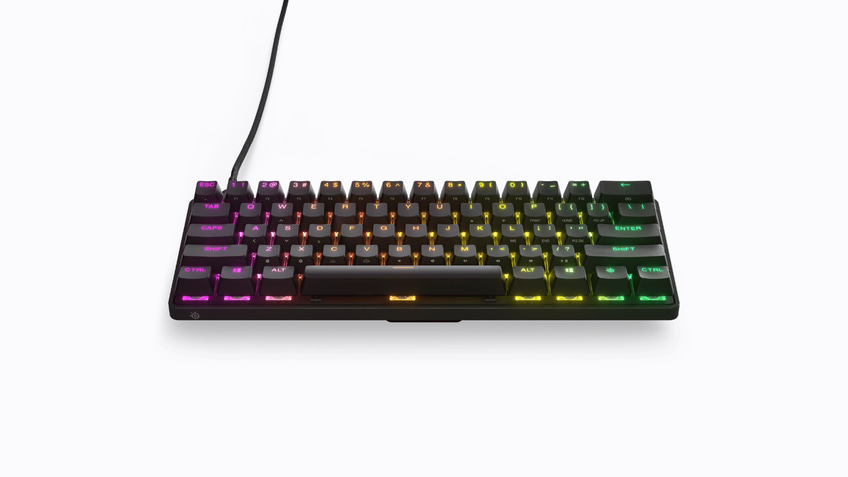


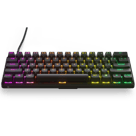


Should I keep my razer huntsman mini or get the apex pro mini
If it’s a Huntsman V3 Pro it’s a better gaming keyboard right now, so I would keep yours. If it’s an older version and you’re mostly concerned with gaming performances, you should get the Wooting 60 HE+ or the Razer Huntsman V3 Pro Mini. The Apex Pro Mini is also a really good gaming keyboard, but the other ones currently have more features (such as Snap Tap) that can improve your gameplay.
Doesn’t cooper use this keyboard aswell? Also should I get the apex pro mini or apex pro tkl
Only respond if you think I should get a Apex pro instead of razer huntsman mini
Hello, I am hesitating about how to choose between Apex pro mini and Wooting 60HE. The former is cheaper, which one should I buy?
When it comes to their overall ingame performance they should be pretty much equal to each other. I sadly don’t have a Wooting 60HE to test myself, but I’ve seen multiple reports online of other reviewers who have compared the two and the difference looks like it isn’t worth the added price (and added wait time) of the Wooting 60HE. I’m personally using the Apex Pro Mini as my main gaming keyboard (I’ve put it inside an aluminum Tofu 60% case and replaced the keycaps) and it’s been performing fantastically. As an added bonus, you don’t need to have SteelSeries’ software open in order to use Rapid Trigger and the likes.
do you know how i can fix my apex pro mini rgb to start working again
If you keyboard is broken I would recommend you to reach out to SteelSeries support.
Activation pressure?
According to the SteelSeries website, it’s 45g.